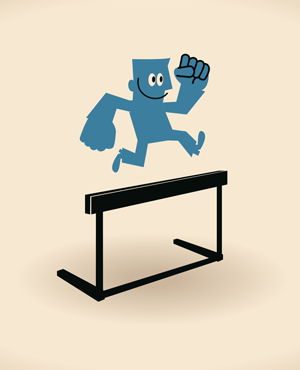 As a student, are you in a home that demands you clean up after others? Or do you find it difficult to motivate yourself to delve into studies after hours of menial tasks around the house? Or do you have children who you’re trying to teach the household chores? If so, I read the perfect book for you to consider: How to Get People to Do Stuff by Susan M. Weinschenk, Ph.D. This book employs all the greatest and latest psychological strategies for getting people to do your bidding, like a sunglasses donning rooster ruling the roost. Your morning crow will surely awaken the household to your agenda after a read of Weinschenk and keep all your chicks in the proper pecking order.
As a student, are you in a home that demands you clean up after others? Or do you find it difficult to motivate yourself to delve into studies after hours of menial tasks around the house? Or do you have children who you’re trying to teach the household chores? If so, I read the perfect book for you to consider: How to Get People to Do Stuff by Susan M. Weinschenk, Ph.D. This book employs all the greatest and latest psychological strategies for getting people to do your bidding, like a sunglasses donning rooster ruling the roost. Your morning crow will surely awaken the household to your agenda after a read of Weinschenk and keep all your chicks in the proper pecking order.
Learn How to Gain Mastery of Any Task, Any Coursework
Don’t you love the sound of the flow of a river with the waves pounded gently against the rocks, tickling your eardrums with that heavenly sound of nature at its finest? Well, imagine entering the zone similar to that sensation, a zone called flow, where your absorption in a task peaks, where time no longer shifts in second increments but breaks into new rhythms. Doesn’t that seem like a good place to begin gaining mastery of a course, a hobby, or an activity?
Weinschenk presents the bottom-line on the flow state: time speeds up for some and slows down for others; our identities must not be threatened as a result of the flow task; the particular activities that generate flow depend on the individual person; flow states stimulate enjoyment. Also, the flow task needs to be somewhat challenging, but not so challenging it seems impossible. The individual needs to self-direct the flow task without interruptions, yet with helpful feedback. With our persistent and never ignoble friend, flow, we eventually gain mastery of the task at hand.
Learn How to Let Your Mind Wander for Greater Creativity
When my mind wanders, an internal alarm sounds, like a blaring siren alerting me to pull-over and claim a ticket for my violation. I am absolute loathe of those moments when my mind veers off course and enters that surreal dimension called the imagination. To prevent my mind from wandering, I like to read consistently, letting the words direct my focus and attention. When my focus strengthens, my mind calms.
When I read Weinschenk’s book, I was taken aback. Mind wandering leads to creativity. In fact, some of the most ingenious findings in fields such as science come from moments of mind wandering. The more your mind wanders off like a dropped ball of yarn, the more likely your creativity is sky high. So, unlike me, don’t fear that wandering beast, but recognize it as your creative gift.
Learn How to Refresh the Brain with Regular Breaks
While doing high school upgrading, an instructor informed me that I should study for thirty minutes and then take a fifteen minute break. Following her instructions, my performance skyrocketed. Psychological research points to the benefits of taking regular breaks throughout any day of tasks, including staring blankly but, oh, so focused, at a computer screen for eight hours straight, barring a half hour break midday. Weinschenk points out that after twenty minutes of concerted thought (in other words, studying time), the brain exhausts itself of its glucose supply necessary for deep thought. Taking a break every twenty minutes will refresh your resources and set you afoot for the next leg of studies.
Learn How to Agree and Then Promptly Disagree
Nice people agree with what you say, don’t they? Don’t we love someone who validates our views, making us feel like the schoolmarm in a room of brownnosers? But who truly wants to be the person to cave into other people’s views, never expressing her own positions for fear of being jabbed with a ballpoint pen in the one remaining patch free eye? Well, according to Weinschenk’s overview of psychological research, you can give in to other people’s views and then fire back with your own, claiming your pristine image of the agreeable one while converting your contender’s viewpoint to yours. Wienschenk shows that the way to agree and then disagree is to agree with your opponent’s view, then produce statistics or evidence to the contrary, and finally, bridge the gap by providing a solution to the evidence to the contrary. That sure beats raising the voice and beating the chest, doesn’t it?
Learn How to Sound Smart with Rhymes
Always anticipate entering the flow state. Does that sound brilliant to you? Well, it should if you wear a white lab coat and fix electrodes on people’s heads. Psychological research suggests that when we say things, like maxims or just plain old statements, that rhyme, we sound smarter than we truly are. Enough said, Fred.
Learn How to Keep Other’s Attention During Your Presentation
Did you remember to change your underwear this morning? Ah, what just happened there? I woke you up from your half-awake slumber from reading through this article. Now that I’ve got you where I want you, I can continue with my rant about Weinschenk’s listing of psychological research. By doing what I just did, adding some surprise, unexpected element, you can keep the attention of your audience during presentations. You don’t have to delve into the underwear or nudity cliches nor slip an amphetamine in your audience’s coffees, but something out of the ordinary will perk up your lulled listeners.
So, that’s how you get people to do stuff like emptying the garbage: by ensuring they identify as master garbage disposers, you’ll get them hooked. No-one takes out a garbage with finesse better than mine, however, so read Susan M. Weinschenk’s How to Get People to Do Stuff, and you too can earn your wings.

